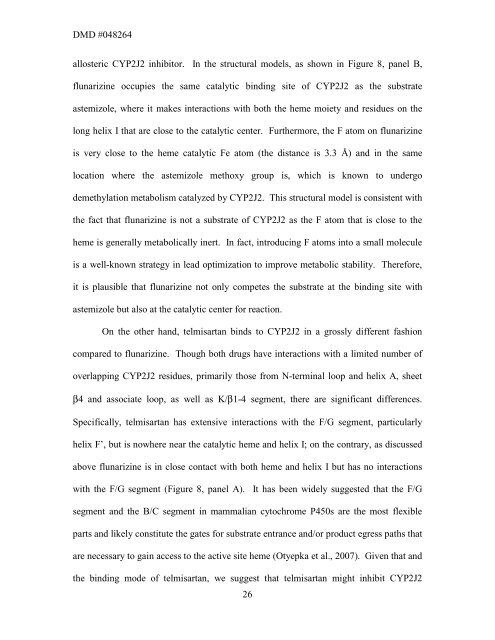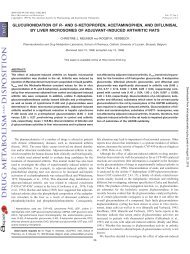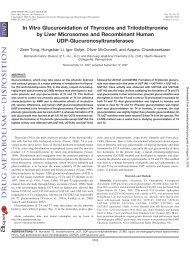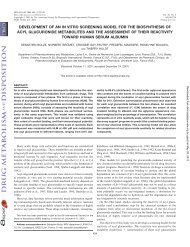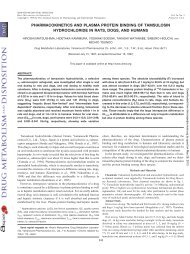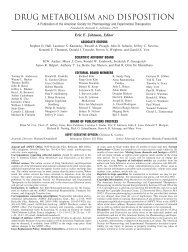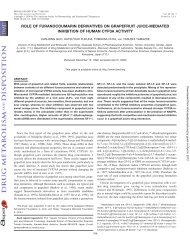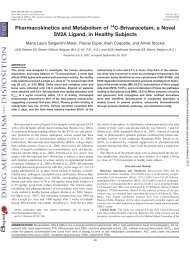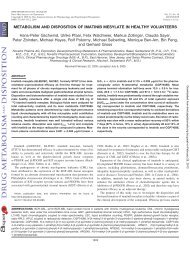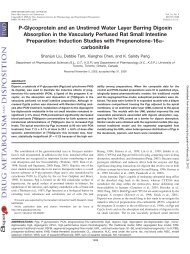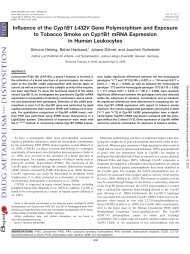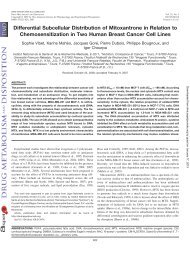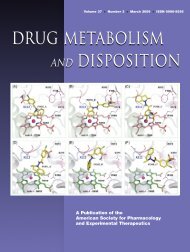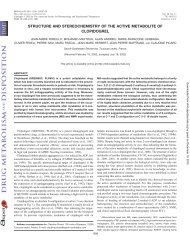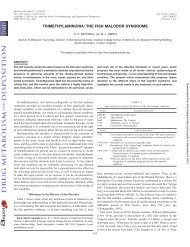DMD #048264 1 Discovery and Characterization of Novel, Potent ...
DMD #048264 1 Discovery and Characterization of Novel, Potent ...
DMD #048264 1 Discovery and Characterization of Novel, Potent ...
Create successful ePaper yourself
Turn your PDF publications into a flip-book with our unique Google optimized e-Paper software.
<strong>DMD</strong> <strong>#048264</strong><br />
allosteric CYP2J2 inhibitor. In the structural models, as shown in Figure 8, panel B,<br />
flunarizine occupies the same catalytic binding site <strong>of</strong> CYP2J2 as the substrate<br />
astemizole, where it makes interactions with both the heme moiety <strong>and</strong> residues on the<br />
long helix I that are close to the catalytic center. Furthermore, the F atom on flunarizine<br />
is very close to the heme catalytic Fe atom (the distance is 3.3 Å) <strong>and</strong> in the same<br />
location where the astemizole methoxy group is, which is known to undergo<br />
demethylation metabolism catalyzed by CYP2J2. This structural model is consistent with<br />
the fact that flunarizine is not a substrate <strong>of</strong> CYP2J2 as the F atom that is close to the<br />
heme is generally metabolically inert. In fact, introducing F atoms into a small molecule<br />
is a well-known strategy in lead optimization to improve metabolic stability. Therefore,<br />
it is plausible that flunarizine not only competes the substrate at the binding site with<br />
astemizole but also at the catalytic center for reaction.<br />
On the other h<strong>and</strong>, telmisartan binds to CYP2J2 in a grossly different fashion<br />
compared to flunarizine. Though both drugs have interactions with a limited number <strong>of</strong><br />
overlapping CYP2J2 residues, primarily those from N-terminal loop <strong>and</strong> helix A, sheet<br />
β4 <strong>and</strong> associate loop, as well as K/β1-4 segment, there are significant differences.<br />
Specifically, telmisartan has extensive interactions with the F/G segment, particularly<br />
helix F’, but is nowhere near the catalytic heme <strong>and</strong> helix I; on the contrary, as discussed<br />
above flunarizine is in close contact with both heme <strong>and</strong> helix I but has no interactions<br />
with the F/G segment (Figure 8, panel A). It has been widely suggested that the F/G<br />
segment <strong>and</strong> the B/C segment in mammalian cytochrome P450s are the most flexible<br />
parts <strong>and</strong> likely constitute the gates for substrate entrance <strong>and</strong>/or product egress paths that<br />
are necessary to gain access to the active site heme (Otyepka et al., 2007). Given that <strong>and</strong><br />
the binding mode <strong>of</strong> telmisartan, we suggest that telmisartan might inhibit CYP2J2<br />
26


